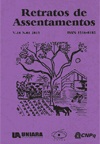Potential use of living fences on rural settlement: a case study in Pitanga settlement, Pernambuco, northeastern Brazil
DOI:
https://doi.org/10.25059/2527-2594/retratosdeassentamentos/2015.v18i1.191Keywords:
Rural Settlement, Atlantic Forest, Biodiversity, Ethnoecology, Sustainable ManagementAbstract
This study assuming that the peasant knowledge and their management practices can result in multidimensional strategies that constitute the diversity of agroforestry, such as living fences. The richness of species employed as living fences and their potential for other uses were evaluated. A discussion about the implications of usage of said species was included, directed at the conservation of local flora. A settlement area, located in a Permanent Preservation Area on the northern coast of the state of Pernambuco (northeastern Brazil), was selected as the model for the study. The area of Cia Paulista Tissues was disappropriate by INCRA (National Institute of Colonization and Agrarian Reform) in 1988 with the struggle for agrarian reform and 172 families were settled. Semi-structured interviews, direct observation, a checklist and the guided tour technique were used for the data collection. Thirty-one species are used as living fences, distributed among 26 genera and 16 families, with a predominance of Euphorbiaceae
and Fabaceae. These plants were allocated in eight other categories of use, with lumber for construction figuring prominently. Knowledge regarding living fences was heterogeneous and concentrated among few informants.
The usage of living fence species can serve multiple utilitarian and ecological purposes, the understanding of which can contribute towards sustainable management, better conservation of either the local flora and the established knowledge of rural populations.
References
ALBUQUERQUE, U. P.; LUCENA, R. F. P.; ALENCAR, N. L. Métodos
e técnicas para a coleta de dados etnobotânicos. In: ALBUQUERQUE, U. P.; LUCENA, R. F. P.; CUNHA, L. V. F. C. (Orgs.). Métodos e técnicas na pesquisa etnobotânica. 2.ed. Recife: COMUNIGRAF/NUPPEA, 2008. p.41–72.
ALBUQUERQUE, U.P; ANDRADE, L. H. C. Conhecimento botânico
tradicional e conservação em uma área de caatinga no estado de Pernambuco Nordeste do Brasil. Acta Botânica Brasilica, v.3, n.16, p.273-285, dez/2002. Disponível em: <http://www.scielo.br/pdf/abb/v16n3/15394.pdf> Acesso em: 6 mar. 2014.
ANDRADE, C. T. S.; MARQUES, J. G. M.; ZAPPI, D.C. Utilização de
cactáceas por sertanejos baianos. Tipos conexivos para definir categorias utilitárias. Sitientibus Série Ciências Biológicas (Etnobiologia), Feira de Santana, v.6, p.3-12. 2006.
ANDRADE-LIMA, D de. Plantas das caatingas. Rio de Janeiro: Academia Brasileira de Ciências. 1989. 243 p.
BAGGIO, A. J.; CARPANEZZI, O. B. Alguns sistemas de arborização de pastagens. Boletim de Pesquisa Florestal, Colombo/PR, v.17, p.47-60, dez. 1988.
BARROS, M. S. Cercas sertanejas: traços ecológicos do sertão pernambucano. 2º. ed. Recife: Massangana, 1985. 81 p.
BHATTARAI, S.; CHAUDHARY, R.P.; Taylor, R.S.L. Plants used as
fence and fuelwood in Manang district, central Nepal. Scientific World, v. 5, n.5, p. 107-111. jul. 2007.
BOTERO, R.; RUSSO, R. Utilización de árboles y arbustos fijadores de nitrógeno en sistemas sostenibles de producción animal en suelos ácidos tropicales. In: SÁNCHEZ, M.; ROMA, M.R. (Org.) Agroforestería para la producción animal en Latinoamérica. Estudio FAO sobre producción y sanidad animal, 1999, p. 171-195.
BRECHELT, A. O Manejo Ecológico de Pragas e Doenças. República
Dominicana: Fundação Agricultura e Meio Ambiente (FAMA). Rede de Ação em Praguicidas e suas Alternativas para a América Latina (RAP-AL). 2004.
BUDOWSKI, G. Living fences in tropical América, a widespread agroforestry practice. In: GHOLZ, H. L. (Org.). Agroforestry, realities and potentials. Dordrecht, Ho, Martinus Nijhoff. 1987. p. 169-178.
BYG, A.; BASLEV, H. Diversity and use of palms in Zahamena, eastern Madagascar. Biodiversity and Conservation, v.10, p.951-970, jun. 2001. Disponível em:<http://link.springer.com/article/10.1023%- 2FA%3A1016640713643#page-1 > Acesso em: 11 mar. 2013.
CONDEPE/FIDEM. Agência Estadual de Planejamento e Pesquisas de
Pernambuco. Prefeitura Municipal de Igarassu. 2007. CPRH - Companhia Pernambucana do Meio Ambiente. Diagnóstico Socioambiental do Litoral. Norte de Pernambuco. Recife, [s.n]. 2005.
CPRM - Serviço Geológico Do Brasil. Projeto cadastro de fontes de
abastecimento por água subterrânea estado de Pernambuco: diagnóstico do município de Abreu e Lima. Mascarenhas, J.C. et al. (org.). Recife, CPRM/PRODEEM. 2005.
CUNHA, L.V.F.C.; ALBUQUERQUE, U.P. Quantitative ethnobotany in
an atlantic Forest fragment of northeastern Brazil – implications to conservation. Environmental Monitoring and Assessment, v. 14, p. 1-25, jan. 2006.
DNIT - Departamento Nacional de Infra-estrutura de Transportes. Cerca viva ou de tela para proteção da fauna – Especificação de serviço. Norma DNIT 077/2006 – ES. Rio de Janeiro, Diretoria de Planejamento e Pesquisa/IPR. 2006.
DUBOIS, J.C.L; VIANA, V.M.; ANDERSON, A.B. Manual Agroflorestal
para a Amazônia. 1 ed. Rio de Janeiro: REBRAF/Fundação Ford,
228 p.
FERRAZ, E.M.N.; RODAL, M.J.N. Caracterização fisionômica - estrutural de um remanescente de floresta ombrófila montana de Pernambuco, Brasil. Acta Botanica Brasílica, Belo Horizonte, v.4, n.20, p.911-926, dez./2006. Disponível em: <http://www.scielo.br/pdf/abb/v20n4/15.pdf >.
Acesso em: 29 jul. 2014.
FERREIRA, R.L.C.; LIRA-JÚNIOR, M.A.; ROCHA, M.S.; LIRA, M.A.;
BARRETO, L.P. Deposição e acúmulo de matéria seca e nutrientes em serrapilheira em um bosque de sabiá (Mimosa caesalpiniifolia Benth.). Revista Árvore, Viçosa/MG, v.1, n.31, p.7–12, jan./fev. 2007. Disponível em: <http://www.scielo.br/pdf/rarv/v31n1/02.pdf>. Acesso em: 19 jun.
GLIESSMAN, S.R. Agroecologia: processos ecológicos em agricultura
sustentável. 3ºed. Porto Alegre: Ed. da UFRGS, 2005. 653 p.
HARVEY, C.A.; VILLANUEVA, C.; VILLACIS, J.; CHACÓN, M.;
MUÑOZ, D.; LÓPEZ, M; IBRAHIM, M.; GOMEZ, R.; TAYLOR, R.;
MARTÍNEZ, J.; NAVAS, A.; SÁENZ, J.; SÁNCHEZ, D.; MEDINA,
A.; VILCHEZ, S.; HERNÁNDEZ, B.; PÉREZ, A.; RUIZ, F.; LÓPEZ,
F.; LANG, I.; KUNTH, S.; SINCLAIR, F.L. Contribución de las cercas
vivas a la productividad e integridad ecológica de los paisajes agrícolas en América Central. Agroforesteriaenlas Américas, Cidade do México, v.10, n.39/40. 2003. Disponível em: <ftp://ftp.fao.org/docrep/nonfao/lead/ x6370s/x6370s00.pdf> Acesso em: 9 jan. 2015.
MARTIN, F.W. The living fence: its role on the small farm. 1991. [Online]. Disponível em: <http://www.tropicalseeds.com/tech_forum/growingtech/living_fence html>. Acesso em 23 mai. 2013.
MATOS, L. V.; CAMPELLO, E. F. C.; RESENDE, A. S.; PEREIRA, J.
A. R.; FRANCO, A. A. Plantio de leguminosas arbóreas para produção de moirões vivos e construção de cercas ecológicas. Sistema de Produção, v.3, p.1-10, dez/2005.
MIRANDA, E. M.; VALENTIM, J. F. Estabelecimento e manejo de cercas vivas com espécies arbóreas de múltiplo uso. Acre: Embrapa Acre, 1998. 4 p. (Série Comunicado Técnico INFOTECA-E).
MONTAGNINI, F. et al. Systemas agrolorestales: princípios y aplicaciones en los trópicos. San José: Organización para Estudios Tropicales. 1992.
MORI, S. A.; SILVA, L.A.M.; LISBOA, G.; CORADIN, L. Manual de
manejo do Herbário fanerogâmico. 2° ed. Ilhéus: Centro de Pesquisa do Cacao. 1989. 103 p.
NASCIMENTO, V. T.; SOUZA, L. G.; ALVES, A. G. C.; ARAÚJO, E. L.;
ALBUQUERQUE, U. P. Rural fences in agricultural landscapes and their conservation role in an area of caatinga (dryland vegetation) in Northeast Brazil. Environment, Development and Sustainability (on line), ago/2008. Disponível em: <http://link.springer.com/article/10.1007%2Fs10668-008-9164-1#page-1>. Acesso em: 25 nov. 2014.
OLIVEIRA, T. K.; ALMEIDA, L. S.; SANTOS, F. C. B.; LESSA, L. S.
Crescimento de mogno e eucalipto como cercas vivas no Acre, Brasil. Revista Brasileira de Agroecologia, Cruz Alta/RS, v.2, n.2, out./2007.
PINTO, E. P. P.; AMOROZO, M. C. M.; FURLAN, E. Conhecimento popular sobre plantas medicinais em comunidades rurais de mata atlântica – Itacaraé, BA, Brasil. Acta Botanica Brasílica, Belo Horizonte, v.4, n.20, p.751–762, out./dez. 2006. Disponível em: <http://www.scielo.br/pdf/abb/v20n4/01.pdf > Acesso em: 7 dez.2013.
RODRIGUES, M. S.; ROLLO, P.A. Estudo de caso: O mercado de terras rurais na região da zona da mata de Pernambuco, Brasil. v. 2.
Santiago de Chile: Red de Desarrollo Agropecuário. Unidad de Desarrollo Agrícola. División de Desarrollo Productivo y Empresarial. 2000.
SILVA, V.A.; ALBUQUERQUE, U.P.; NASCIMENTO, V.T. Técnicas
para análise de dados. In: ALBUQUERQUE, U.P.; LUCENA, R.F.P.;
CUNHA, L.V.F. C. (org.). Métodos e técnicas na pesquisa etnobotânica. Recife: COMUNIGRAF/Nupeea. 2008. p. 127-143.
TORQUEBIAU, E. Are tropical agroforestry homegardens sustainable? Agriculture Ecosystems and Environment, v.41, p.189–207, 1992. Disponível em: <http://gcs.isp.unu.edu/db/sites/default/files/16.Are%20tropical%
agroforestry%20home%20gardens%20sustainable.pdf>. Acesso
em: 15 abr. 2013.
VILLANUEVA, C; IBRAHIM, M; HARVEY C.; ESQUIVEL, H. Tipologías
de fincas con ganadería bovina y cobertura arbórea en pasturas en
el trópico seco de Costa Rica. Agroforestería en las Américas, Turrialba (Costa Rica), v.10, p.9-16, 2003. Disponível em: <ftp://ftp.fao.org/docrep/nonfao/lead/x6371s/x6371s00.pdf>. Acesso em: 28 mai. 2014.
ZAHAWI, R.A. Establishment and Growth of Living Fence Species: An Overlooked Tool for the Restoration of Degraded Areas in the Tropics. Restoration Ecology, Washington (USA), v.1, n.13, p.92-102, mar./2005. Disponível em: <http://globalrestorationnetwork.org/uploads/files/CaseStudyAttachments/94_zahawi-1.pdf> Acesso em: 22 set. 2014.
Downloads
Published
How to Cite
Issue
Section
License
O(s) autor(es) autoriza(m) a publicação do artigo na revista;
• O(s) autor(es) garante(m) que a contribuição é original e inédita e que não está em processo de avaliação em outra(s) revista(s);
• A revista não se responsabiliza pelas opiniões, ideias e conceitos emitidos nos textos, por serem de inteira responsabilidade de seu(s) autor(es);
• É reservado aos editores o direito de proceder ajustes textuais e de adequação do artigo às normas da publicação.
Autores mantêm os direitos autorais e concedem à revista o direito de primeira publicação, com o trabalho simultaneamente licenciado sob a Licença Creative Commons Attribution, que permite o compartilhamento do trabalho com reconhecimento da autoria e publicação inicial nesta revista.
Autores têm autorização para assumir contratos adicionais separadamente, para distribuição não exclusiva da versão do trabalho publicada nesta revista (ex.: publicar em repositório institucional ou como capítulo de livro), com reconhecimento de autoria e publicação inicial nesta revista.
Autores têm permissão e são estimulados a publicar e distribuir seu trabalho online (ex.: em repositórios institucionais ou na sua página pessoal) a qualquer ponto antes ou durante o processo editorial, já que isso pode gerar alterações produtivas, bem como aumentar o impacto e a citação do trabalho publicado (Veja O Efeito do Acesso Livre) em http://opcit.eprints.org/oacitation-biblio.html














